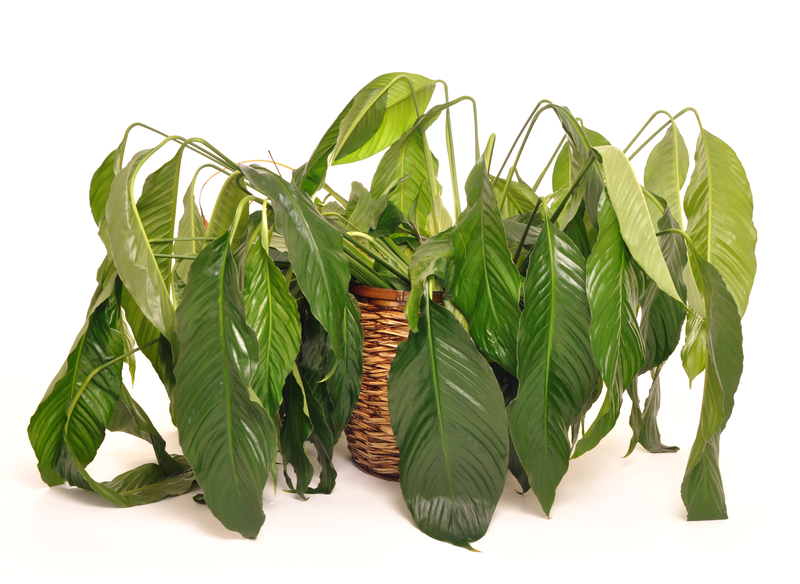How to Develop an Inclusive Garden for Young Minds
Posted on 09/09/2025
How to Develop an Inclusive Garden for Young Minds
Gardens are much more than mere plots of greenery--they are natural classrooms where curiosity blossoms and imaginations run wild. Creating an inclusive garden for young minds is a meaningful step towards nurturing a generation that appreciates diversity, nature, and hands-on learning. Whether you are an educator, parent, or community leader, designing an inclusive garden isn't just about plants--it's about fostering an environment where every child feels valued, engaged, and inspired. In this comprehensive guide, we'll explore effective strategies, creative ideas, and best practices to ensure your garden is accessible, educational, and enjoyable for all children.

What is an Inclusive Garden?
An inclusive garden is a thoughtfully designed outdoor space that enables children of all abilities, backgrounds, and learning styles to participate, explore, and contribute. Whether it's a schoolyard patch, a neighborhood green spot, or a community project, inclusivity ensures every child--regardless of physical, cognitive, or social needs--can interact comfortably with nature and with peers.
Why Inclusion Matters in a Children's Garden
- Promotes equality: All children gain the chance to participate equally, breaking down barriers imposed by disability, language, or cultural differences.
- Enhances learning: Inclusive gardens support different learning styles through hands-on, sensory-rich, and experiential activities.
- Boosts confidence and social skills: Working together in a shared environment cultivates friendships, empathy, and communication skills.
- Fosters respect for diversity: Children learn to appreciate different perspectives and abilities while caretaking a shared space.
Planning Your Inclusive Garden for Young Learners
Before breaking ground, careful planning is crucial. Consider the ages, needs, and backgrounds of the young children who will use the garden. A truly inclusive garden design involves input from children, parents, teachers, and specialists.
Key Steps in Planning an Inclusive Educational Garden
- Engage Stakeholders Early: Involve parents, teachers, occupational therapists, and students in the planning process to ensure the space meets a range of needs and expectations.
- Choose a Suitable Location: Ensure the site has safe access, adequate sunlight, water sources, and a secure boundary if required. Consider proximity to classrooms or recreational areas.
- Conduct a Needs Assessment: Survey potential users about desires, challenges, and special requirements. Pay attention to mobility, sensory sensitivities, language barriers, and cultural preferences.
- Set Clear Objectives: Define what you want the garden to achieve--learning goals, social development, environmental stewardship, or all the above.
Designing an Accessible and Welcoming Garden Space
A child-inclusive garden layout should empower all children to participate. Accessible design doesn't just mean ramps and wide paths--it's about fostering comfort, security, and engagement for everyone.
Elements of an Inclusive Garden Design
- Accessible Paths: Create wide, smooth paths with non-slip surfaces. Ramps with gentle slopes are essential for wheelchair users and strollers. Paths should be clearly marked and unobstructed.
- Raised Beds: Install raised garden beds of varying heights to accommodate wheelchair users and those with limited mobility. Children can reach in, plant, and harvest without strain.
- Sensory Zones: Dedicate sections to plants that stimulate the senses--aromatic herbs (like lavender), textured leaves, edible plants, and colorful flowers encourage tactile and olfactory exploration.
- Quiet Retreats: Incorporate small seating nooks or shady corners for children who might become overwhelmed. These "calm zones" offer comfort and time for reflection.
- Multi-Sensory Signage: Use large fonts, braille, and pictorial signs for plant identification and instructions. QR codes linked to audio or video guides are helpful for non-readers or visually impaired children.
- Safe, Non-Toxic Materials: All structures, paths, and garden items should use non-toxic, weatherproof materials, free from sharp edges or choking hazards.
Adapting for Varying Needs
Children come with diverse needs, and a well-designed garden addresses them all:
- Physical disabilities: Accessible paths, raised beds, handrails, and adaptive gardening tools with easy-grip handles.
- Sensory needs: Zoned activity areas, quiet retreats, and plants selected for their calming or stimulating effects.
- Language and cultural diversity: Multilingual signs, culturally significant plants, and activities celebrating diverse food and garden traditions.
- Neurodiversity: Visual schedules, predictable routines, and sensory-friendly zones support children on the autism spectrum.
Choosing Inclusive Plants and Activities
Selecting the right mix of plants and garden activities can transform your inclusive space into a rich learning landscape. Focus on diversity, accessibility, and engagement.
Ideal Plant Choices for Young Gardeners
- Easy-to-grow varieties: Sunflowers, radishes, lettuce, and beans provide quick, visible results.
- Edible plants: Berries, peas, and cherry tomatoes invite picking and tasting, highlighting nature's bounty.
- Sensory plants: Lamb's ear, mint, rosemary, and marigold offer distinctive textures, scents, and colors.
- Pollinator-friendly flowers: Zinnias, cosmos, and lavender attract bees and butterflies, supporting ecological education.
Tip: Involve children in plant selection--let them vote or help choose a "plant of the month." This creates a sense of ownership and excitement.
Inclusive Garden Activities for Children
- Seed starting: Use large seeds easy for small hands to handle, and start in labeled pots.
- Watering routines: Assign roles in a watering "relay" using lightweight watering cans or adapted bottles for children with limited strength.
- Art in the garden: Nature rubbings, plant labeling, or making garden signs embrace different learning styles.
- Story time outdoors: Combine reading with garden exploration using books about plants, insects, or multicultural gardening stories.
- Harvest feasts and cooking: Organize tasting days or cook simple recipes together, exploring new tastes and cultural traditions.
Creating a Safe and Supportive Environment
A truly inclusive garden for young minds is built on principles of safety and emotional well-being as much as physical accessibility.
Safety Guidelines for an Inclusive School or Community Garden
- Supervision: Always ensure children are supervised by adults trained in inclusivity and first aid.
- Toxic plant avoidance: Do not include plants known to be poisonous or cause allergic reactions.
- Clear boundaries: Use fences, plant borders, or colorful markings to define safe play and gardening zones.
- Allergy awareness: Survey participants for allergies (plant, bee, food) and make necessary accommodations.
- Safe storage: Keep tools and chemicals locked away and provide child-friendly versions for use.
Educator and Volunteer Training for Inclusivity
An inclusive infant or children's garden thrives under the guidance of adults committed to learning, patience, and adaptability.
- Inclusivity workshops: Run regular training on diversity, equity, social-emotional learning, and adaptive gardening techniques.
- Collaboration with specialists: Involve occupational or speech therapists and special educators for advice on tools, signage, and accessibility.
- Encouraging empathy and peer support: Teach children how to offer help while respecting independence and promoting friendship.
Engaging Families and the Community
For an inclusive children's garden to thrive, the whole community must get involved. Parents, local organizations, and cultural groups can enrich the space with their wisdom, resources, and traditions.
- Family planting days: Organize weekend "dig-in" events where families can work, learn, and share garden duties.
- Cultural celebrations: Situate garden festivals or tasting events around cultural holidays and traditional crops.
- Community partnerships: Reach out to local farms, businesses, and nonprofits for support, funding, or volunteer help.
Adapting Through the Seasons
An inclusive educational garden is more than a summer project. With planning, curiosity can be nurtured year-round.
- Spring: Start seeds indoors, observe pollinators, and map out planting plans.
- Summer: Tend and harvest crops, observe butterflies, and keep outdoor lessons short to beat the heat.
- Fall: Explore composting, harvest root vegetables, and organize art with autumn leaves.
- Winter: Plan for next year, start an indoor herb garden, or visit local greenhouses together.
Measuring Success & Continuously Improving
A successful child-centric inclusive garden isn't built overnight. Stay flexible, celebrate progress, and measure success in creative ways.
- Feedback circles: Hold regular meetings inviting feedback from students, staff, and families--what's working, and what could improve?
- Garden journals: Have children record observations, stories, or drawings in personal journals to track their journey.
- Photo timelines: Document the garden's growth and use images to celebrate milestones and inspire others.
- Annual reviews: Survey participants at the end of each year and adapt plans based on evolving needs and interests.
Resources for Designing Inclusive Gardens
- Accessible Gardening Toolkits: Look for organizations like National Gardening Association, KidsGardening.org, and local botanic gardens for practical tips and free materials.
- Grant Programs: Seek funding from education departments, environmental grants, or health charities supporting inclusive outdoor play.
- Expert Consultation: Partner with child development experts, horticulturists, and accessibility advocates for in-depth advice.

Conclusion: Growing Young Minds, Cultivating Inclusion
Developing an inclusive garden for young minds is a transformative endeavor. These gardens give children a sense of belonging, teach vital life skills, and connect future generations with nature and each other. With thoughtful planning, creativity, and community spirit, any space can become an inclusive haven where young minds thrive--no matter their abilities or backgrounds. Start today, and watch your garden--and your children--grow stronger together.
Frequently Asked Questions about Inclusive Gardens for Kids
- How do you ensure gardens are accessible for children with disabilities?
Design with ramps, raised beds, wide paths, and easy-to-reach tools. Consult accessibility guidelines and involve families in the process. - What are the benefits of diverse planting in children's gardens?
Diverse plants increase sensory experiences, support pollinators, accommodate dietary/cultural needs, and fuel curiosity. - How can I include families from different backgrounds?
Invite cultural input, use multilingual signs, celebrate diverse crops, and host inclusive community events. - What if we have limited space or budget?
Start small with container gardens, window boxes, or a single raised bed. Seek grants, donations, and in-kind community support.
By embracing inclusivity and innovation, you can use the power of gardening to nurture imagination, respect, and lifelong learning in every child. Start planting seeds of inclusion today!

